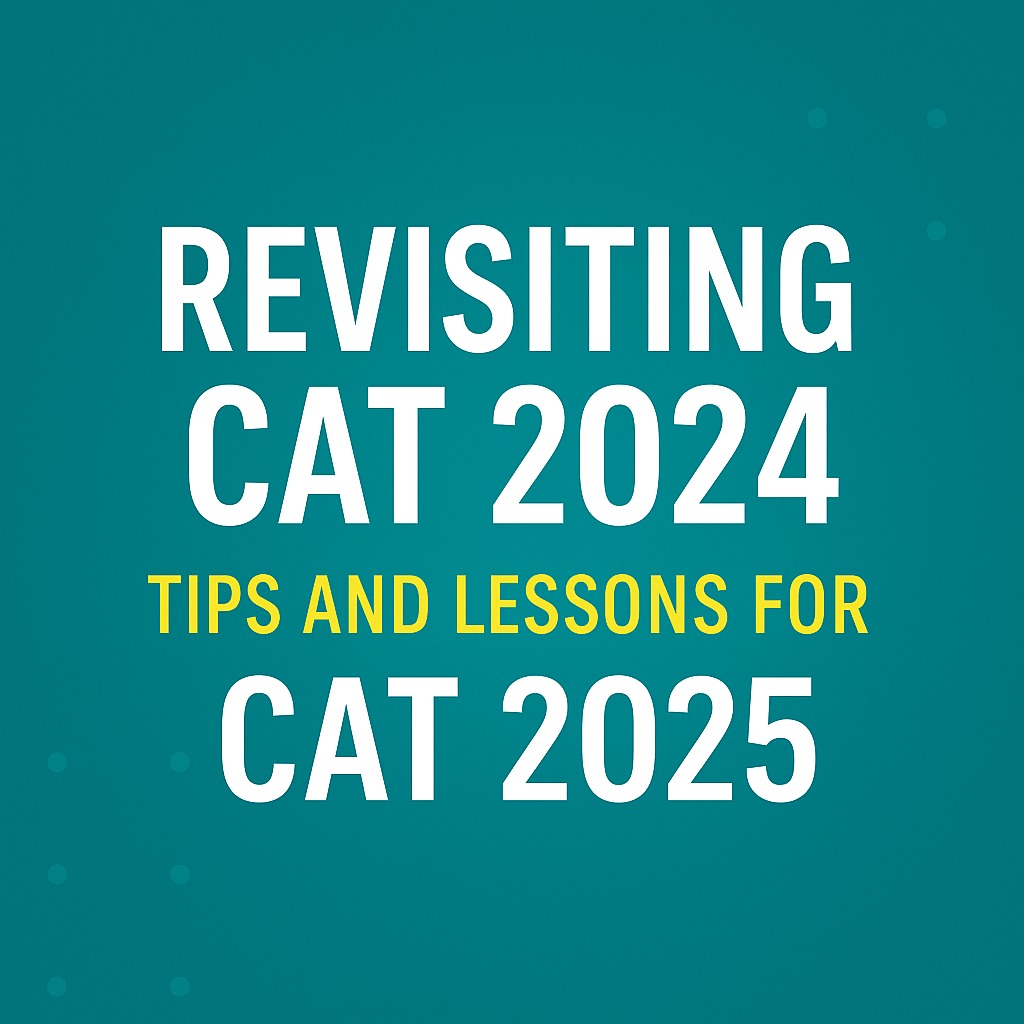🗣️ CAT 2024 Verbal Ability (VARC) Section Analysis: Slot-Wise Breakdown & Lessons for CAT 2025

The VARC section of CAT 2024 continued its recent tradition of being conceptually RC-heavy, with moderate Verbal Ability (VA) and plenty of traps in answer choices. The key differentiator, once again, was accuracy in reading and elimination. 🧠 Overview of VARC 2024 Total Questions: 24 Reading Comprehension (RC): 16 Qs (4 passages × 4 Qs each) Verbal Ability (VA): 8 Qs (Para-summary, Para-jumbles, Odd One Out) TITA: Most VA questions were TITA Overall Difficulty: Slot 1: Moderate to Tough Slot 2: Moderate Slot 3: Easy to Moderate SLOT-WISE VERBAL ANALYSIS 📌CAT 2024 – Slot 1: Moderate to Tough 📚 RC Breakdown: RCs were dense and abstract—topics from sociology, psychology, ecology, and AI ethics. Options were close and confusing, with 2–3 answer choices often seeming correct. No direct inference questions—all required careful reading + elimination. ✍️ VA Breakdown: 2 Para-jumbles (TITA): Moderate, 4–5 sentence types 2 Para-summaries (MCQ): Tricky—close options 2 Odd One Out: Abstract arguments 🔍 Key Observations: RC passages were wordy and idea-dense (~500–600 words each). Para-summary questions had subtle shifts in tone and detail. Many reported low accuracy despite “feeling good” during the section. 🎯 Good Attempts: 16–18 ✅ Good Score: 36–40 📌 CAT 2024 – Slot 2: Moderate 📚 RC Breakdown: One passage on economics and inflation, another on evolutionary biology, a third on media influence, and one on AI & cognition. Medium length (~450–550 words); questions required detail-based understanding. Some direct inference + main idea questions provided relief. ✍️ VA Breakdown: 3 Para-jumbles (TITA): Moderate 2 Para-summaries: One easy, one tricky 1 Odd One Out: Easy 🔍 Key Observations: RC was more balanced—neither too factual nor too abstract. VA section was manageable, especially for those familiar with structure-based solving. High ROI possible for those with reading habits. 🎯 Good Attempts: 18–20 ✅ Good Score: 40–45 📌 CAT 2024 – Slot 3: Easy to Moderate 📚 RC Breakdown: Topics included history of architecture, digital privacy, climate narratives, and psychology of habits. Passages were readable and shorter (~400–500 words). Questions were more direct, with fewer traps. ✍️ VA Breakdown: 2 Para-jumbles (TITA): Easy 2 Para-summaries: Direct and answerable 2 Odd One Out: Moderate 🔍 Key Observations: Reading speed helped a lot in this slot. Many students finished with 2–3 minutes to spare. Ideal slot for those confident in reading comprehension. 🎯 Good Attempts: 20–22 ✅ Good Score: 45–50 📊 Comparative Snapshot Feature Slot 1 Slot 2 Slot 3 Overall Difficulty Moderate to Tough Moderate Easy to Moderate RC Tone Abstract, dense Balanced Easy & factual VA Difficulty Moderate Easy–Moderate Easy Good Attempts 16–18 18–20 20–22 Good Score (Raw) 36–40 40–45 45–50 🔑 What CAT 2025 Aspirants Should Learn RC is Still the King RC makes up 66% of the section. Practicing with a mix of abstract and factual articles is key. Tone & Inference Mastery Trap options test your understanding of tone, scope, and logical flow—not just facts. Practice with TITA Para-jumbles Accuracy in TITA comes only through muscle memory—solve 100+ PJs before October. Make Reading a Daily Habit Read articles from Aeon, NYT, The Guardian, The Hindu, Eon, Nautilus, and JSTOR to simulate CAT-style RCs. Mock Smartly, Not Just Hard Analyze not just the questions you got wrong, but also the ones you got right for the wrong reason. Here’s a complete, month-wise preparation plan for CAT 2025 – Verbal Ability and Reading Comprehension (VARC), aligned with CAT 2024 trends and smart strategy: 📅 CAT 2025 VARC Preparation Plan (June–November) Target: 98+ percentile with strong RC and VA accuracy ✅ JUNE – Foundation Phase Goals: Build reading habits, understand CAT VARC structure, and begin light practice. 📚 Focus Areas: Read 1 long article daily (700–1000 words) Topics: Philosophy, Psychology, Economics, Environment, Sociology Learn question types: Main idea, inference, tone, summary 📝 Practice: 2 RCs/week from previous CAT papers 5 Para-jumbles and 2 Para-summary questions/week Start a “Words in Context” vocabulary journal ✅ JULY – RC Skills + VA Foundations Goals: Strengthen comprehension and start solving VA seriously 📚 RC Focus: RC Strategy: Elimination > Selection Practice 3 RCs/week: Time-bound (12–15 mins each) Learn to identify: Author’s tone Main argument Contradictions and comparisons ✍️ VA Focus: Para-jumbles (4-sentence, 5-sentence) – 20/week Para-summary – 10/week Odd One Out – 5/week ✅ AUGUST – Accuracy Building Phase Goals: Balance speed with comprehension, increase exposure to TITA formats 📚 RC Focus: 4 RCs/week from mock level material Practice: Inference-based, assumption, tone, application Qs Track accuracy using RC logs (create error tracker) ✍️ VA Focus: Time-bound VA sets: 6–8 Qs in 20 mins Deep analysis of confusing questions Reinforce grammar intuitively (through reading, not rules) ✅ SEPTEMBER – Mock Integration Phase Goals: Shift from practice to simulated testing 🧪 Mock Strategy: Full 40-min VARC sections twice a week 1 Full-length CAT mock/week Analyze: % accuracy Qs skipped Trap choices 📚 RC: 5 RCs/week from past CATs + mock-level Use time blocks: 30 mins = 2 RCs ✍️ VA: Focus on difficult para-summaries & odd-one-outs Maintain TITA question logs Practice VA under sectionals ✅ OCTOBER – Final Refinement Goals: Fix weak zones, improve test temperament 🧠 What to Do: 3 mocks/week with full VARC analysis RCs: Push reading speed to 250–300 wpm VA: Solve past 5 years’ actual CAT VA questions Analyze incorrect TITA logic ✅ NOVEMBER – Exam Temperament + Micro-Focus Goals: Maximize performance in 40 mins 🧪 Weekly Routine: 4 sectionals (VARC) + 3 full CAT mocks Revise RC themes and tone vocabulary Practice RCs across slots (CAT 2023, 2024) ✍️ Additional Tools Tool/Activity Frequency Read newspapers/articles Daily (45 mins) Maintain vocab/context log 3x/week Revise VA errors Weekly VARC Group Discussions Weekly (1 hr) 📚 Recommended Reading Sources Source Focus The Hindu (editorials) Tone, structure, Indian context Aeon / Eon Philosophy, Psychology NYT / The Guardian Global issues, Opinion pieces JSTOR Daily Abstract RC practice For more information or to buy magic toolkit product contact or click CAT 2025 Magic Toolkit
Revisiting CAT 2024 & Targeting CAT 2025: The Big Picture

As we get into the final few laps for CAT 2025 lets revisit CAT 2024 and take key lessons in our journey to CAT 2025. CAT 2024 introduced notable tweaks compared to previous years yet retained its fundamental challenge: 120 minutes to solve 68 questions across three sections. According to coaching-institute analyses and student feedback, CAT 2024 was overall more approachable than CAT 2023, especially in DILR and Quantitative Ability, but this made benchmarks and cut-offs more competitive at top B-schools. Understanding these changes and their implications is crucial for CAT 2025 aspirants aiming to stay ahead. Pattern Changes & Structure Total Questions: 68 (VARC: 24, DILR: 22, QA: 22) Section Timing: 40 minutes each. VARC Tweaks: Complete removal of Paragraph Jumble. Instead, more emphasis on paragraph completion, summary, and odd-sentence (TITA) questions DILR Tweaks: Increased to 5 sets (2 sets of 5 Qs, 3 sets of 4 Qs) totaling 22 questions, up from 20 in earlier patterns. QA Composition: Arithmetic-heavy (around 8–10 questions), with Algebra, Geometry, Number Systems, and Modern Math making up the remainder. Question Types: Mix of MCQs (with negative marking) and TITA (no negative marking). The balance across MCQ/TITA varied section-wise (e.g., more TITA in DILR). Difficulty Level: Slot-wise variations, but overall moderate; easier than CAT 2023 in many aspects, especially DILR and QA, though VARC maintained moderate challenge. Because the exam was slightly “easier,” percentile cut-offs at premier IIMs likely edged upward; thus, aspirants needed to aim for even higher raw scores to secure the same percentiles as previous years. Section-Wise Analysis & Key Takeaways VARC (Verbal Ability & Reading Comprehension) Question Distribution: Approximately 16 Reading Comprehension (RC) questions + 8 Verbal Ability (VA) questions, but with no para-jumbles. Instead, VA featured summary, paragraph completion, and odd-sentence (TITA) items Difficulty: Generally easy to moderate for RC passages, with a mix of easier and moderate-length passages. VA questions required strong elimination instincts and clarity in sentence usage. Attempts & Accuracy: Students reported targeting around 12–14 attempts with 60–70% accuracy to secure a safe percentile in VARC. Overthinking often led to time loss; trusting reading instincts paid off. Strategy Lessons: Active Reading Practice: Regularly practice varied RCs to build speed and comprehension. Focus on identifying main ideas, tone, and structure quickly. VA Question Drills: Prioritize exercises on paragraph completion and summary questions under timed conditions. Develop clarity on sentence coherence to tackle odd-sentence TITA items confidently. Time Allocation: Avoid spending excessive time on any single passage or question. Practice pacing to attempt all RCs first, then VA, or vice versa, based on personal strength. DILR (Data Interpretation & Logical Reasoning) Question Distribution: 5 sets totaling 22 questions (2 sets × 5 Qs, 3 sets × 4 Qs). A blend of DI caselets (tables, graphs) and LR puzzles (arrangements, tournaments, assignment problems). Difficulty: Moderate overall and easier compared to CAT 2023 DILR. However, certain sets still demanded multi-step reasoning, careful data filtering, and accuracy under time pressure. Attempts & Accuracy: Quality over quantity—targeting around 10–13 questions with high accuracy (80%+ for safe percentile). Skipping a deceptively tough set early could improve overall score. Strategy Lessons: Set Selection: Develop the skill to quickly gauge set difficulty in the first 1–2 minutes—identify whether information is structured clearly or too convoluted for your comfort. Practice Diverse DI Formats: Regularly solve graph/table caselets and varied LR puzzles under timed mocks. Exposure reduces hesitation on exam day. Accuracy Focus: Since negative marking applies to MCQs, avoid guessing. For TITA questions (no negative), attempt only when reasonably sure. Time Management: Allocate time flexibly—if one set stalls your momentum, move on and return only if time permits. QA (Quantitative Ability) Composition: Arithmetic-dominant (around 8–10 questions), plus Algebra, Geometry, Number Systems, and Modern Math (permutations, probability). Difficulty: Moderate overall; easier than CAT 2023, but still challenging for accuracy under time constraints. Many straightforward-looking questions could be time-consuming if fundamentals weren’t rock-solid. Attempts & Accuracy: Aiming for about 10–12 attempts with 70–80% accuracy was typical for a strong percentile. Strategy Lessons: Fundamentals Mastery: Strengthen arithmetic basics (percentages, ratios, time & work, speed & distance) through daily practice. Make formula recall second nature. Speed & Calculation Practice: Use shortcuts judiciously but ensure they don’t invite errors. Practice mental math to save precious seconds. Topic-wise Mock Analysis: Post-mock, analyze which topics consume excess time or cause errors. Devise targeted practice for weak areas. Balancing Easy vs. Time-Consuming: Learn to identify “windfall” questions vs. trap questions early. Attempt easy ones first to build confidence and bank marks. Slot-Wise & Overall Student Feedback Slot Variations: Slot 1 was reported as slightly tougher in QA than Slot 2/3; VARC sometimes felt tougher in Slot 3 due to passage topics. However, differences were marginal overall. Psychological Factors: Anxiety on exam day impacted attempt order; many aspirants preferred starting with their strongest section (e.g., QA first for some) to build momentum. Post-Exam Reflection: High-performing students emphasized mock simulations under strict timed, proctored conditions to mimic real exam pressure. Cut-off Implications: Since CAT 2024 was marginally easier, the cut-offs for IIMs likely rose by a few raw-score points. Aspirants needed to aim for higher safe attempts than in previous years. Lessons & Tips for CAT 2025 Preparation Revisiting CAT 2024 helps shape an effective prep roadmap for CAT 2025. Below are distilled insights and actionable tips: Start Early & Build Fundamentals Begin with Basics: From Day 1, reinforce arithmetic concepts, grammar rules, and logical reasoning principles. A strong foundation pays dividends in mock performance. Structured Study Plan: Create a weekly/monthly calendar, allotting dedicated slots to VARC, DILR, QA, revision, and rest. Consistency beats cramming. Mock Test Series: Simulate Real Exam Conditions Realistic Environment: Take full-length mocks in a proctored, timed setting to build exam temperament. This reduces anxiety on D-Day. Sectional Mocks & Analysis: Regular sectional tests help isolate weak areas early. Post-mock, invest time in deep analysis—identify time-sinks, error patterns, conceptual gaps. Adaptive Practice & Feedback Loop Data-Driven Improvement: Track performance metrics (attempts vs. accuracy vs. time taken) for each topic. Use this
